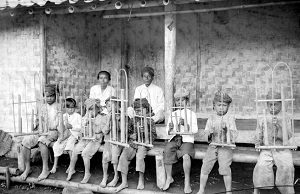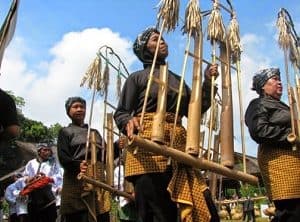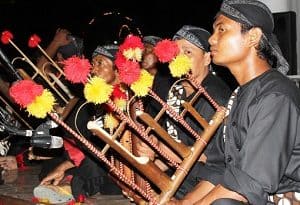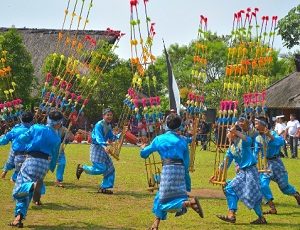Angklung is one of traditional music instrument of Indonesia. Angklung is the mythology of the Balinese language, namely Ang, which means the number (in the form of notes) and Klung which means broken. So, if combined Aangklung means the broken number. In the development of Angklung itself, the melody slowly began to change and adapt to the development era.
See also: Indonesia Military Power – Indonesian Red Cross Society
Here is the list of interesting fact about Angklung:
Fact 1 – Angklung Origin
 A record regarding to the origin of Angklung emerging at the era of the kingdom of Sunda (12th century until the 16th century).
A record regarding to the origin of Angklung emerging at the era of the kingdom of Sunda (12th century until the 16th century).
There is also an assumption that the primitive forms of Angklung has been used in Neolithic culture that developed in Indonesia until the beginning of the modern calendar.
Meaning that Angklung is part of the relics of pre-Hinduism in the culture of Indonesia.
See also: Most Expensive Universities in Indonesia – Indonesian Politics
The origin of the creation of bamboo music like Angklung was based by the worldview of agrarian society of Sundanese. Rice as the lifeblood of Sundanese, gave birth to the myth of the belief in the Nyai Sri Pohaci as a symbol of Dewi Padi, the giver of life (hirup-hurip). Baduy people, who are considered as the remnants of the original Sundanese people, applying Angklung as part of the ritual before planting rice.
See also:
Fact 2 – Types of Angklung
The next of Indonesian Angklung Facts is types. There are many types of Angklung, in which each have their own uniqueness, such as:
1. Angklung Kanekes
 Angklung Kanekes is an Angklung from Kanekes area (we often call them “Bedouins”). Angklung Kanekes is use primarily because of its association with the rite of rice, not solely for the entertainment of people.
Angklung Kanekes is an Angklung from Kanekes area (we often call them “Bedouins”). Angklung Kanekes is use primarily because of its association with the rite of rice, not solely for the entertainment of people.
In Kanekes, not everyone can make Angklung Kanekes. The people whose entitled to make Angklung is the Kajeroan (Tangtu; Baduy Jero). Then, Kajeroan consists of three villages, namely Cibeo, Cikartawana, and Cikeusik. Even in these villages, not everyone can make it, only the entitled people can do it, Thus, there are special requirements of ritual.
See also: Endangered Animals in Indonesia – National Library of Indonesia
For entertaiment, Angklung usually play when the moon is bright and not raining. People play Angklung in buruan (a large courtyard in the countryside) while singing various songs, among others:
- “Kasarung”,
- “Yandu Bibi”,
- Yandu Sala”,
- “Ceuk Arileu”,
- “Oray-orayan”,
- “Dengdang”
- “Yari Gandang”,
- “Oyong-oyong Kuhl”,
- “Body Kula”,
- “Kokoloyoran”,
- “swing-swing”,
- “Pileuleuyan,” and more.
See also: Luwak Coffee –Indonesian Landmarks
2. Angklung Reyog
 Angklung Reyog is a traditional musical instrument made of bamboo with a red and yellow yarn as the decoration. Meanwhile, Angklung Reyog usually play along with the art of Reog Ponorogo dance in East Java. Angklung Reyog have specific characteristics, such as:
Angklung Reyog is a traditional musical instrument made of bamboo with a red and yellow yarn as the decoration. Meanwhile, Angklung Reyog usually play along with the art of Reog Ponorogo dance in East Java. Angklung Reyog have specific characteristics, such as:
- Have a handle on the end of the Angklung which used to hold the Angklung. This allowed one person holds two Angklung.
- At the end of the bamboo, given the threads of red and yellow with the purpose to paralyze the enemy when they approach.
- There is a bamboo arch on each on a large bamboo tube.
- It has only two tones, the big sound of the klong-klong and the small sound of klung-klung.
See also: Gamelan Facts – Indonesian Traditional Transportation
3. Angklung Dogdog Lojor
 The art of Dogdog Lojor in Pancer Pangawinan Kasepuhan community or the customs union of Banten Kidul. Then, its spread around Mountain Mist (bordering Jakarta, Bogor and Lebak).
The art of Dogdog Lojor in Pancer Pangawinan Kasepuhan community or the customs union of Banten Kidul. Then, its spread around Mountain Mist (bordering Jakarta, Bogor and Lebak).
Meanwhile, what Dogdog Lojor has anything to do with Angklung Dogdog Lojor? Angklung Dogdog Lojor is the name of one of the instruments in it.
The using of Angklung in the art of Dogdog Lojor is because of its connection with the ritual of rice. Once a year, after harvest, the whole community held a traditional events, or Seren Taun Taun Serah in the center of the village.
See also: Poverty in Indonesia – Best Airport in Indonesia
The instruments used in the art of Dogdog Lojor is two pieces of Dogdog Lojor and four pieces of large Angklung. Each Angklung have its own name, which is the largest called Gonggong. Then, there are Panembal, Kingking, dan Inclok. Each instrument is played by one, so that there are six people altogether.
See also: Indonesian Language – Indonesia Religion
4. Buncis
 Buncis is an entertainment performance art from Baros (Arjasari, Bandung). The name of Buncis art is related to a text of the famous song among the people, namely cis chickpeas nyengcle …, etc. The text contained in the Buncis art, therefore, the art is called Buncis
Buncis is an entertainment performance art from Baros (Arjasari, Bandung). The name of Buncis art is related to a text of the famous song among the people, namely cis chickpeas nyengcle …, etc. The text contained in the Buncis art, therefore, the art is called Buncis
At first, Bucis only used at events associated with rice farming, but now, Buncis are used as entertainment too. The 1940s can be regarded as the end of the ritual function in respect of rice beans.
The instruments use in the art of Angklung Buncis are two indung, two Angklung ambrug, Angklung panempas, two pancer Angklung, one enclok Angklung.
Then three pieces Dogdog, consisting of one talingtit, panembal, and badublag. As time goes by, there are few addition such as tarompet, manacle, and goong.
See also: Indonesian democracy – Indonesian Martial Arts
5. Angklung Gubrag
Angklung Gubrag begins at the time when Cipining village had a very bad season, in the most infamous myth. Angklung Gubrag come from Cipining village, Cigudeg district, Bogor. Angklung was used to honor Dewi Padi (Paddle fairy) in the activities of melak pare (rice growing), ngunjal pare (transporting rice), and ngadiukeun (put) to leuit (barn).
See also: Bali Facts – Bali Tribes
6. Angklung Badeng
Angklung Badeng is coming from Badeng, Sanding village, the district of Malangbong. Badeng is a type of art that emphasizes the musical aspect with Angklung as the main musical instrument.
There are nine pieces of Angklung used in Badeng, such as, two Angklung roel, one Angklung kecer, four Angklung indung and bapa, two children Angklung; two pieces of Dogdog, two Gembyung, and one Kecrek. The text uses the Sundanese language mixed with Arabic. In development, now, it use Indonesian too.
See also: Indonesia Java – Indonesian National Flower
Then, the other types of Angklung, such as:
- Angklung Banyuwangi: Angklung Banyuwangi has a form like calung with tones culture of Banyuwangi.
- Angklung Bali: Angklung Bali has a shape and tone that distinctive Bali.
See also: Indonesia Java – Unique Facts about Indonesia
Fact 3 – Angklung Development
 The music of Angklung is slowly began to change and adapt to the development era. Starting from Daeng Sutisna who successful changing petatonis become diatonic scales (do, re, mi, fa, sol, la, si, do) in 1983. Then, the development began to growth, for example in the Asian-African Summit in Bandung, West Java.
The music of Angklung is slowly began to change and adapt to the development era. Starting from Daeng Sutisna who successful changing petatonis become diatonic scales (do, re, mi, fa, sol, la, si, do) in 1983. Then, the development began to growth, for example in the Asian-African Summit in Bandung, West Java.
Modern Angklung music played for official events in Indonesia Ultimate Diversity, namely the Indonesian national anthem and some famous folk songs like Rasa Sayange, Ayo Mama, Brother Bird Old and Duck Goose.
See also: Dayak Tribe – Biggest Earthquake in Indonesia
Saung Angklung Udjo, an angsana singgasana of Angklung world was built in 1961. Then, its still active maintaining Angklung until this very moment.
Essentially, Angklung is played by shaking it. It will never be change. However, a variety of creative attempts to modernize continues gradually, such as:
- Electrically Angklung by Agus Suhardiman.
- Automatic Angklung , Kadek Kertayasa’s final task in STIKOM Surabaya.
- Tra-digi, an Angklung robot controlled by i-pod, the creation of Hasim Ghozali.
- Klungbot, robotic Angklung that developed by Krishna Diastama and Karismanto Rahmadika in the beginning, followed by Eko Budi Mursito.
Fact 4 – Achievements
One of Indonesian Angklung Facts is its achievements. Even for Indonesian people, still not many knows that Angklung has been known in world stage. One of countries is Europe. Its from Keluarga Paduan Angklung (KPA) SMAN 3 Bandung, one of senior high school choir club. They made breakthroughs to held Expand The Sound of Angklung (ESA). ESA is an music event where KPA has joined three categories in Europe music festival.
On the other hand, ESA has been held and participated for four times in 2002, 2004, 2008, and 2010. There are so many achievements on the list, such as:
[table]
[tr][th]No[/th] [th]Year[/th] [th]Achievements[/th][/tr]
[tr][td]1[/td] [td]2002[/td] [td]
- 29th International Folklfestival in Gannat, France.
- 19th International Folklfestival in Moerbeke-Waas, Belgium.
- Expand The Sound of Angklung 2002 also held two concert in Heidelberg and Kiel, Germany.
[/td][/tr]
[tr][td]2[/td] [td]2004[/td] [td]
- Aberdeen International Youth Festival (AIYF) in Aberdeen, Scotland This festival is the biggest youth festival in the world, which focusing on development of music and theatre of youth.
- 36th International Festival of Mountain Folklore in Zakopane, Polandia This is one of the oldest competition on folk tradition. KPA3 is invited as the first participant ever from Indonesia. In this festival, KPA3 achieved 3 trophies.
[/td][/tr]
[tr][td]3[/td] [td]2008[/td] [td]
- 2008 International of Petras, Greece § 2008 Norbanus Festival at Norma, Italy.
- 2008 Festival of Rassegna at Castigleone del Lago, Italy.
- 2008 International Society of Music Education International Conference at Bologna, Italy.
[/td][/tr]
[tr][td]4[/td] [td]2010[/td] [td]
- International Festival Folkart Maribor ( June 29th – July 3rd, 2010
- Summa Cum Laude International Youth Music Festival Vienna ( July 3rd – July 8th, 2010 ) Hosted by VIA MUSICA (Vienna International Association for Music and Culture Exchange) and provides a unique platform for the world’s most talented youth choirs, bands and orchestras
- International Folk Festival (Festival Internacional de Folklore) of Ciudad Real (July 13th –July 20th, 2010) Organized by Association of Songs and Dances of Ciudad Real (Mazantini Group)
- International Folk Festival (Festival Folklorico Internacional) of Extremadura, Badajoz (July 21st –July 29th 2010)
[/td][/tr]
[/table]
These Indonesian Angklung facts have successfully show how extraordinary Angklung is. As one of Indonesian heritage and also Indonesian cultures, Angklung went from simply being a traditional musical instrument which not many people know, into the most well-known traditional musical instrument from Indonesia.
